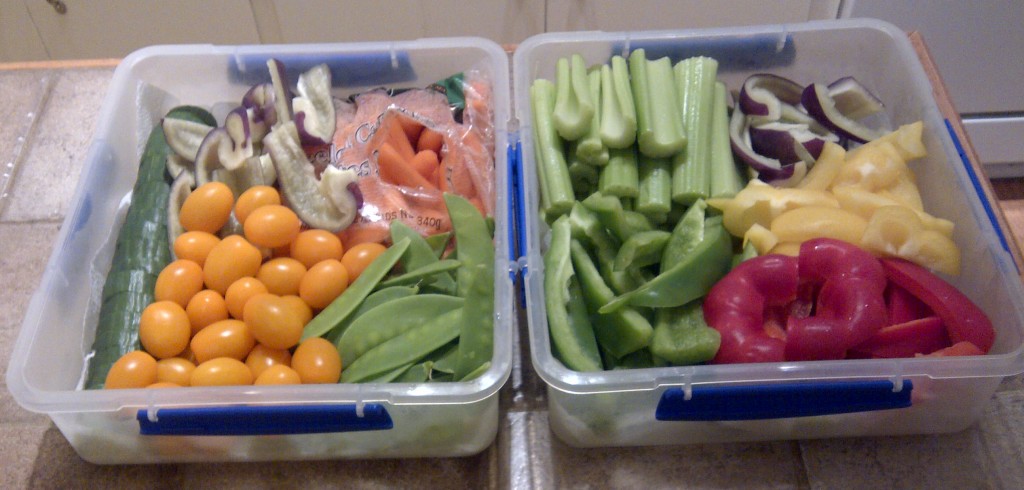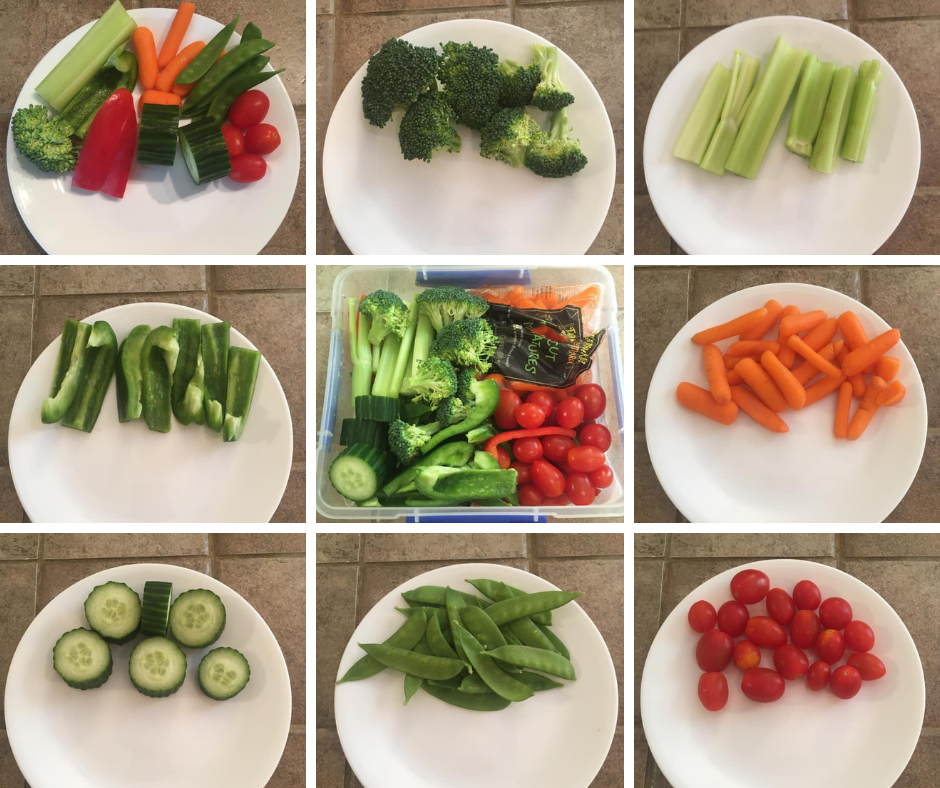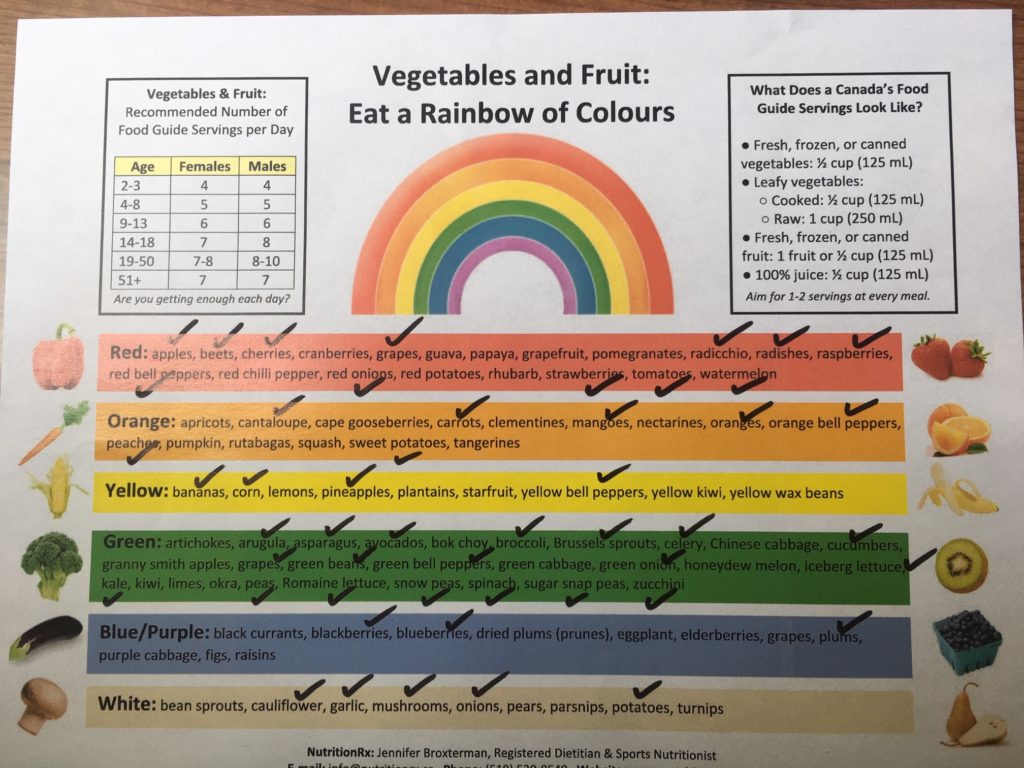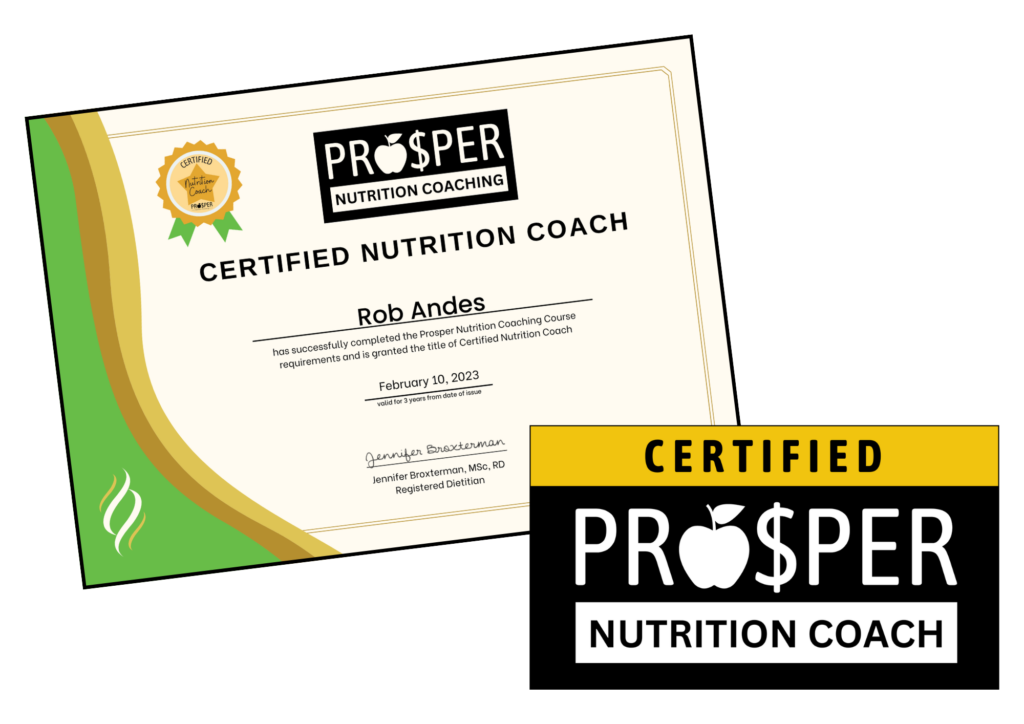

5 Simple Ways to Eat More Veggies
5 Simple Ways to Eat More Veggies
Written by Jennifer Broxterman, MSc, RD
Registered Dietitian, Founder of NutritionRx
Sometimes I wonder if the reason so many of us have trouble eating our veggies is because our mothers sounded like broken records growing up—”Eat your veggies, eat your veggies, one more bite”—that we rebelled against it and have never quite recovered.
Either that, or it seems like an effort to chop them, dice them, cook them. Or maybe we just plain old don’t think they taste very good. While how to make veggies taste great is the subject of another blog, let’s talk about strategies for helping you consume more nutrient-dense, all-important vegetables of all kinds.
1. Veggie Bucket
Once a week, I like to spend about 5 minutes chopping a variety of fresh, in-season vegetables for the week, which I leave in plain view (i.e. easy access in the fridge) because:
- We prioritize convenience: Especially when we’re hungry, we tend to reach for what’s easy.
- We eat more of what we visually see: This is why it’s important to leave them in plain view and not in the veggie crisper (aka what I call the “Drawer of Death”), where good intentions go to die, like that limp celery and rotten tomato you intended to incorporate into your dinner last week.

Pro tip: I recommend chopping veggies for your tupperware bucket the moment you come home from grocery shopping, before you even put them away. This is the easiest way to anchor this into a habit. In psychology, it’s the principle of glueing one habit onto another.
- For example, after you shampoo your hair, you condition it. This shampoo-conditioner process is so ingrained, you don’t think about stopping after the shampoo. If you do it enough times, the same can happen with the Veggie Bucket habit—and your brain will automatically start to do things in this order:
1) grocery shop
2) come home and put fresh food away
3) wash and chop your vegetables to make a Veggie Bucket
Gamify the process: I started making veggie buckets during my undergrad degree. Sometimes I was tempted to skip it because I’d come home and feel overwhelmed by the amount of homework I had to get through. So I started timing myself as a sort of challenge. As my knife skills improved, pretty soon I could chop veggies for the whole week faster than it took me to listen to Britney Spears’ Toxic (yes, that song was cool at the time). Of course, you’re free to pick your own song, but I highly recommend Toxic: the perfect veggie bucket song.
Final thought: If you’re worried about vegetables going bad, which can happen sometimes, especially if you bought them on sale to clear and they’re organic, it helps to put a paper towel down at the bottom of the tupperware and cut them into fatter chunks, and always make sure the lid is sealed to keep as much oxygen out as possible.
2. Mix It Up (Use Variety to your Advantage)

It’s easy to get sick of vegetables if all you do is cycle back and forth between broccoli and carrots.
If you keep your grocery receipts, go ahead and take a look. Most people come home with the same handful of produce items each time they shop.
Instead, challenge yourself to expand the variety of vegetables you eat, and experiment with different ways of cooking them: steamed, sauteed, grilled on the BBQ, pureed into a soup, crunchy and raw, etc.
Pro tip: The next time you go shopping, buy a vegetable you have never bought before. Better yet, buy a vegetable you don’t know how to pronounce and have no clue what it tastes like (figuring out how to cook it is what Google is for). See if you can try one new vegetable a week for the next two months.
- This also helps you develop the mindset of abundance, as opposed to focusing on all the bad foods you’re trying to stay away from. This creates less deprivation and more enjoyment from the foods you eat.
Speaking of bad foods: We seem to have demonized certain fruits and vegetables. Aren’t bananas super high on the glycemic index and full of sugar? Same as carrots, right? (I can promise you this: carrots and bananas aren’t the reason people end up obese with chronic health conditions like Type 2 diabetes).
My rule of thumb: If nature made the food, and the food is unaltered (i.e. whole food), go for it! There is nothing more basic and natural than eating fruits and vegetables the way nature intended them to be eaten.
Gamify the process: Again, if you’re into turning these things into challenges, play the Rainbow Game. Start counting the number of different colours, and shades of various colours, you eat. How big can you get this number by the end of the month through trying various vegetables and new recipes, or maybe resurfacing old recipes. More on that here.

3. Half a Plate
The idea here is to strive to fill 50 percent of your lunch and dinner plates to be filled with vegetables—so they roughly stretch the size of one outstretched hand.
Pro tip: Don’t include the following vegetables in your half-a-plate of free vegetables (consider them a starch or a carb): white potatoes, sweet potatoes, green peas, corn, squash, turnips, parsnips, and beets.
- Again, this doesn’t mean you shouldn’t have the above vegetables. Simply don’t count them as part of your half plate of vegetables, but go right ahead and count them towards a high quality carb, especially if you live an active lifestyle.

4. Seatbelt Rule
What’s the first thing you do when you get into a car?
You put on your seatbelt, of course.
Start thinking about putting vegetables on your plate as a seatbelt. Start with the vegetables first.
- It might take a conscious effort when you first start doing this, but if you keep doing it, day after day, eventually you won’t have to think about it. It’s not like your New Year’s resolution has ever been “put my seat belt on every time I’m in the car.” You do it without realizing it. That’s the power of a habit. So if you stick with it, eventually veggies on the plate first will be so automatic it’ll happen naturally to the point that if there’s no veggie option at a meal, it’ll start to feel like something’s wrong, like riding in a car without your seatbelt buckled.
Here’s an analogy I like: Taking a little bit of money each month and putting it into your retirement savings account is a way of protecting yourself from spending too much now. It’s the same idea here. Putting veggies on your plate first protects you from filing your plate with the higher calorie part of the meal. If veggies are left to the end, I promise you there won’t be half a plate left to make room for broccoli or a spinach salad, because the spaghetti and meatballs will be dominating the space.
5. 6-Servings a Day Game
So by now you know I like games.
Another game I like to play is the six servings a day game.
Just like the name says, challenge yourself to eat six servings of vegetables a day (one serving being a fistful of vegetables, or roughly ½ cup for those of you who like things to be a little more precise). Keep track of this on a calendar. At the end of each day, write down the number of servings of vegetables you ate that day. Can you hit 40 plus in one week?
Remember, by following the half plate guide, you’ll be eating roughly an outstretched hand’s worth of vegetables at lunch (for most people, that’s usually around 1.5 – 2 cups), and another outstretched hand’s worth of vegetables at dinner (that’s another 1.5 – 2 cups), that easily put you at 6-8 total servings of veggies per day. Amazing!
The Bottom Line:
So many diets ask us to eliminate food, to restrict calories in an exclusive kind of way. The idea here is the exact opposite: It’s an inclusive approach to eating that actually asks you to eat more.
- Instead of feeling deprived like during the last diet you tried, you will feel free to eat guilt free. Of course, the idea here is that when you prioritize vegetables—six servings a day—you’ll be filling yourself with so much nutrient dense foods that you’ll have less room for the higher calorie, less nutrient dense options.
Wishing you health & happiness,
♡ Jen
Jennifer Broxterman, MSc, RD
Registered Dietitian
NutritionRx: happy, healthy living with our team of Registered Dietitians
Prosper Nutrition Coaching: a world-class nutrition coaching certification
+
+
+
Want to work with a NutritionRx Registered Dietitian?
Learn more here: Nutrition Packages & Rates
+
+
+
Want to become a Certified Nutrition Coach?
Learn more about our habits-based Prosper Nutrition Certification



